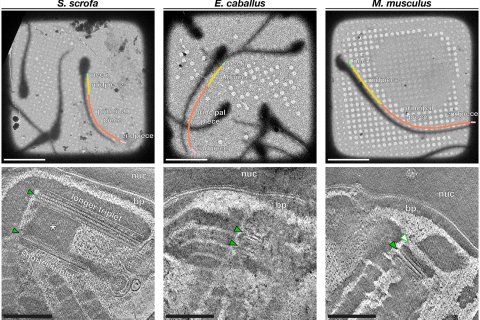Sperm motion backed by surprisingly complex structures
Researchers uncover key elements of sperm cell movement and rigidity
By analysing sperm cells in extraordinary detail, researchers have uncovered key elements that support sperm motion and rigidity. The discovery, made by Utrecht University scientists, may lead to new directions for treating male infertility and developing male contraceptives.
Using cutting-edge electron microscopy techniques, researchers from Utrecht University reveal how different components of sperm cells interact to form compact and streamlined cells. Their results provide vital information on how the molecular architecture supports cell movement, which is crucial for fertilization.
Optimised for swimming

Sperm cells are some of the smallest cells found in humans. On the way to becoming highly streamlined cells, optimised for finding and fusing with an egg cell, sperm loses most its cellular components. By comparing insides of sperm cells from different species of mammals, the team revealed how the remaining cell components are organised to form a swimming cell.
Unique asymmetrical architecture
The machinery required to propel sperm resides in the cell’s tail. It’s built of a vast array of molecular components that work together in a closely orchestrated fashion. The team discovered how the hundreds of motor and structural proteins are arranged in the tail, as well as how they are coupled to generate movement.
Their study also demonstrates that this unique molecular architecture allows for asymmetrical alignments in the tail. This is needed to generate the distinct ‘swinging’ that allows sperm to travel through the viscous fluid of the female reproductive track. The team published their finding in The EMBO Journal.
Coordinating head and tail movement
The team also discovered previously unknown details of a key element involved in harmonising the sperm’s head and tail during movement. The movement starts in the tail, induced by so-called motor proteins. This movement must then be coupled to the head, so that part can move as well. Creating such a coordinated movement is crucial for a sperm cell’s success. Only when the head and tail movements are balanced, the sperm cell is able to move forward.
Structures in the connecting piece between head and tail proved to be a key factor in coordinating sperm cell movement
The team focused on a region that connects the tail and head, known as the connecting piece. The part hosts structures called centrioles. Most mammalian cells contain two centrioles, which generally play a key role in assisting cell division and acting as a rigid base for tail structures.
Shock absorber
“Normally a centriole doesn’t show internal movement, and is regarded as a shock absorber”, says Tzviya Zeev-Ben-Mordehai, a structural biologist at Utrecht University and the team leader. Her team discovered that the two sperm centrioles have very a different structure; one having a more typical barrel structure, but the other showing a very atypical structure.
The explanation for the atypical structure of the second centriole was revealed in a follow-up study in collaboration with Tomer Avidor-Reiss from the University of Toledo in the USA. The researchers unexpectedly found that the atypical centriole is part of an asymmetric chamber that has internal movement. Based on their results they propose that the atypical centriole may have evolved to serve as a mechanical transducer to coordinate the tail and head movement. The researchers published these results in Nature Communications.
In the case of unexplained infertility, examining the centrioles might unveil a problem with sperm cell movement
Looking deeper into male infertility
The team’s findings could be relevant for diagnosing infertility in humans. “When studying human fertility, researchers generally measure numbers of sperm cells or their movement”, says Zeev-Ben-Mordehai. “But in the case of unexplained infertility you may need to look deeper. Examining the centrioles might unveil a problem with movement. Based on that information, a fertility doctor might choose a different approach, and for instance suggest an ICSI procedure instead of IVF.”
Male contraceptives without hormones
On the other hand, the results of this research could open up possibilities for developing male contraceptives that don’t involve hormones, says Zeev-Ben-Mordehai. “We need to understand the molecular details of how movement is generated by sperm. Once we understand it well, we can find ways to block it, put a spoke in the wheel.”
Extraordinary detail

The researchers were able to see cell details in sperm cells that have never been observed before, thanks to a relatively new microscopic technique called cryogenic electron microscopy (cryo-EM). A major benefit of cryo-EM over standard electron microscopy is that samples requires much less preparation. This way, samples are better preserved and can retain their natural condition more closely.
With standard electron microscopy, samples can only be observed after being dehydrated and coated with heavy atoms. With cryo-EM, none of these steps are required. The only preparation consists of rapidly cooling the sample. “This is the best sample preparation you can get”, says Zeev-Ben-Mordehai. “You’re studying the native condition of the sample.”
Electron microscopy
Both studies by Zeev-Ben-Mordehai and colleagues was performed in cooperation with Utrecht University’s Electron Microscopy Centre and the Netherlands Centre for Electron Nanoscopy.
Publicaties
A dynamic basal complex modulates mammalian sperm movement
Nature Communications, 21 June 2021. DOI: 10.1038/s41467-021-24011-0
Sushil Khanal, Miguel Ricardo Leung*, Abigail Royfman, Emily L. Fishman, Barbara Saltzman, Hermes Bloomfield-Gadêlha, Tzviya Zeev-Ben-Mordehai*, Tomer Avidor-Reiss
* = Onderzoeker aan de Universiteit Utrecht
The multi-scale architecture of mammalian sperm flagella and implications for ciliary motility
The EMBO Journal, 1 april 2021. DOI: 10.15252/embj.2020107410
Miguel Ricardo Leung*, Marc C Roelofs*, Ravi Teja Ravi*, Paula Maitan*, Heiko Henning*, Min Zhang*, Elizabeth G Bromfield*, Stuart C Howes*, Bart M Gadella*, Hermes Bloomfield-Gadêlha, Tzviya Zeev-Ben-Mordehai*
* = Onderzoeker aan de Universiteit Utrecht

